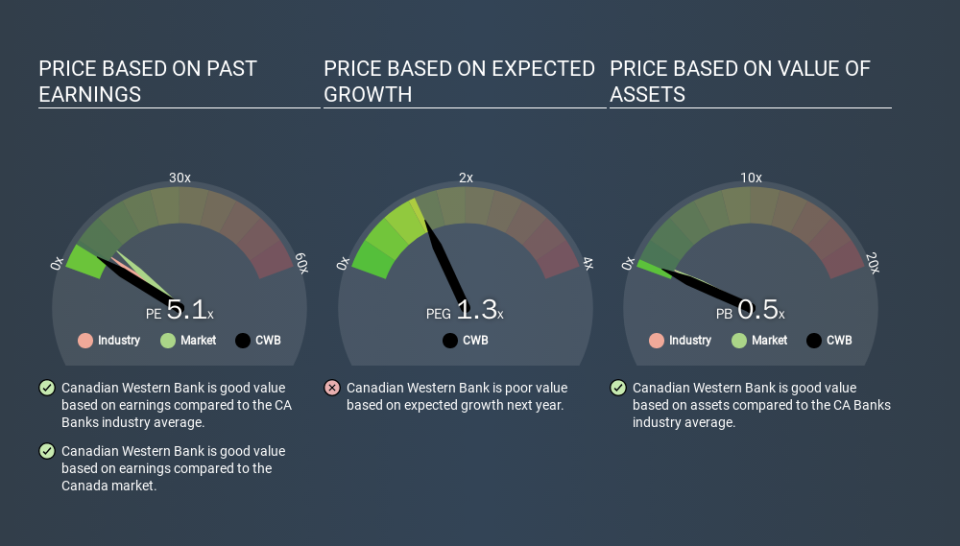A Sliding Share Price Has Us Looking At Canadian Western Bank's (TSE:CWB) P/E Ratio

To the annoyance of some shareholders, Canadian Western Bank (TSE:CWB) shares are down a considerable 51% in the last month. That drop has capped off a tough year for shareholders, with the share price down 44% in that time.
Assuming nothing else has changed, a lower share price makes a stock more attractive to potential buyers. While the market sentiment towards a stock is very changeable, in the long run, the share price will tend to move in the same direction as earnings per share. So, on certain occasions, long term focussed investors try to take advantage of pessimistic expectations to buy shares at a better price. One way to gauge market expectations of a stock is to look at its Price to Earnings Ratio (PE Ratio). A high P/E implies that investors have high expectations of what a company can achieve compared to a company with a low P/E ratio.
Check out our latest analysis for Canadian Western Bank
How Does Canadian Western Bank's P/E Ratio Compare To Its Peers?
We can tell from its P/E ratio of 5.06 that sentiment around Canadian Western Bank isn't particularly high. The image below shows that Canadian Western Bank has a lower P/E than the average (6.4) P/E for companies in the banks industry.
Its relatively low P/E ratio indicates that Canadian Western Bank shareholders think it will struggle to do as well as other companies in its industry classification. While current expectations are low, the stock could be undervalued if the situation is better than the market assumes. If you consider the stock interesting, further research is recommended. For example, I often monitor director buying and selling.
How Growth Rates Impact P/E Ratios
Generally speaking the rate of earnings growth has a profound impact on a company's P/E multiple. When earnings grow, the 'E' increases, over time. That means unless the share price increases, the P/E will reduce in a few years. So while a stock may look expensive based on past earnings, it could be cheap based on future earnings.
Canadian Western Bank increased earnings per share by 9.2% last year. And earnings per share have improved by 3.7% annually, over the last five years.
Don't Forget: The P/E Does Not Account For Debt or Bank Deposits
It's important to note that the P/E ratio considers the market capitalization, not the enterprise value. Thus, the metric does not reflect cash or debt held by the company. In theory, a company can lower its future P/E ratio by using cash or debt to invest in growth.
While growth expenditure doesn't always pay off, the point is that it is a good option to have; but one that the P/E ratio ignores.
Canadian Western Bank's Balance Sheet
Canadian Western Bank has net cash of CA$9.7m. That should lead to a higher P/E than if it did have debt, because its strong balance sheets gives it more options.
The Verdict On Canadian Western Bank's P/E Ratio
Canadian Western Bank trades on a P/E ratio of 5.1, which is below the CA market average of 9.2. EPS was up modestly better over the last twelve months. And the healthy balance sheet means the company can sustain growth while the P/E suggests shareholders don't think it will. Given Canadian Western Bank's P/E ratio has declined from 10.3 to 5.1 in the last month, we know for sure that the market is more worried about the business today, than it was back then. For those who prefer invest in growth, this stock apparently offers limited promise, but the deep value investors may find the pessimism around this stock enticing.
Investors should be looking to buy stocks that the market is wrong about. As value investor Benjamin Graham famously said, 'In the short run, the market is a voting machine but in the long run, it is a weighing machine. So this free report on the analyst consensus forecasts could help you make a master move on this stock.
Of course, you might find a fantastic investment by looking at a few good candidates. So take a peek at this free list of companies with modest (or no) debt, trading on a P/E below 20.
If you spot an error that warrants correction, please contact the editor at editorial-team@simplywallst.com. This article by Simply Wall St is general in nature. It does not constitute a recommendation to buy or sell any stock, and does not take account of your objectives, or your financial situation. Simply Wall St has no position in the stocks mentioned.
We aim to bring you long-term focused research analysis driven by fundamental data. Note that our analysis may not factor in the latest price-sensitive company announcements or qualitative material. Thank you for reading.

 Yahoo Finance
Yahoo Finance 
